Hell's Kitchen, Manhattan
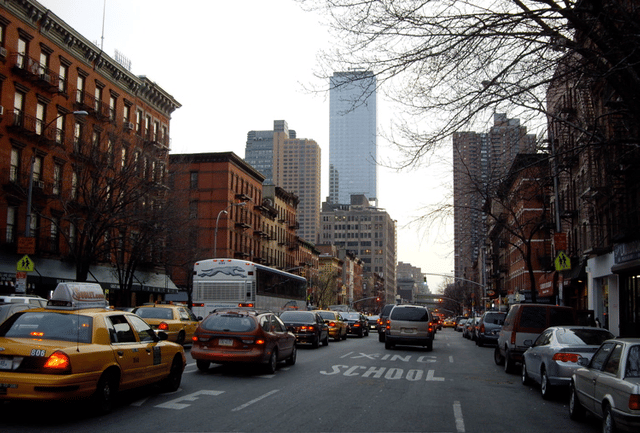
Hell's Kitchen, Manhattan

Hell's Kitchen | |
|---|---|
Neighborhood of Manhattan | |
| Nickname(s): HK, Clinton | |
 | |
| Coordinates:40°45′50″N 73°59′31″W [173] | |
| Country | |
| State | |
| City | |
| Borough | |
| Community District | Manhattan 4[2] |
| Area | |
| • Total | 0.841 sq mi (2.18 km2) |
| Population | |
| • Total | 45,884 |
| • Density | 55,000/sq mi (21,000/km2) |
| Ethnicity | |
| • White | 56.4% |
| • Asian or Pacific Islander | 15.0% |
| • Hispanic | 19.3% |
| • Black | 6.3% |
| • Other | 3.0% |
| Economics | |
| • Median income | $98,727 |
| Time zone | UTC−05:00 (Eastern) |
| • Summer (DST) | UTC−04:00 (EDT) |
| ZIP Codes | 10018, 10019, 10036 |
| Area code | 212, 332, 646, and 917 |
Hell's Kitchen, sometimes known as Clinton, is a neighborhood on the West Side of Midtown Manhattan in New York City. It is traditionally considered to be bordered by 34th Street to the south, 59th Street to the north, Eighth Avenue to the east, and the Hudson River to the west.
Once a bastion of poor and working class Irish Americans, Hell's Kitchen's location in Midtown has changed its personality since the 1970s. Though Hell's Kitchen's gritty reputation had long held real-estate prices below those of most other areas of Manhattan, by 1969, the City Planning Commission's Plan for New York City reported that development pressures related to its Midtown location were driving people of modest means from the area. Since the early 1990s, the area has been gentrifying, and rents have risen rapidly. Located close to both Broadway theatres and the Actors Studio training school, Hell's Kitchen has long been a home to learning and practicing actors and actresses, and, in recent years, to young Wall Street financiers.[6] The area provides transport, medical, and warehouse-infrastructure support to Midtown's business district. In modern times, it is also known for its extensive selection of multi-ethnic, small, and relatively inexpensive restaurants, bars, and associated nightlife.
Hell's Kitchen is part of Manhattan Community District 4 and its primary ZIP Codes are 10018, 10019, and 10036.[2] It is patrolled by the 10th and 18th Precincts of the New York City Police Department.
Hell's Kitchen | |
|---|---|
Neighborhood of Manhattan | |
| Nickname(s): HK, Clinton | |
 | |
| Coordinates:40°45′50″N 73°59′31″W [173] | |
| Country | |
| State | |
| City | |
| Borough | |
| Community District | Manhattan 4[2] |
| Area | |
| • Total | 0.841 sq mi (2.18 km2) |
| Population | |
| • Total | 45,884 |
| • Density | 55,000/sq mi (21,000/km2) |
| Ethnicity | |
| • White | 56.4% |
| • Asian or Pacific Islander | 15.0% |
| • Hispanic | 19.3% |
| • Black | 6.3% |
| • Other | 3.0% |
| Economics | |
| • Median income | $98,727 |
| Time zone | UTC−05:00 (Eastern) |
| • Summer (DST) | UTC−04:00 (EDT) |
| ZIP Codes | 10018, 10019, 10036 |
| Area code | 212, 332, 646, and 917 |
Boundaries

Location map of Hell's Kitchen in Manhattan
The name "Hell's Kitchen" generally refers to the area from 34th to 59th Streets. Starting west of Eighth Avenue and north of 43rd Street, city zoning regulations generally limit buildings to six stories. As a result, most of the buildings are older, and are often walk-up apartments. For the most part, the neighborhood encompasses the ZIP Codes 10019 and 10036. The post office for 10019 is called Radio City Station, the original name for Rockefeller Center on Sixth Avenue.[7]
The neighborhood overlaps Times Square and the Theater District to the east at Eighth Avenue. On its southeast border, it overlaps the Garment District also on Eighth Avenue. Two landmarks are located here – the New Yorker Hotel at 481 Eighth Avenue, and the Manhattan Center building at the northwest corner of 34th Street and Eighth Avenue. Included in the transition area on Eighth Avenue are the Port Authority Bus Terminal at 42nd Street, the Pride of Midtown fire station (from which an entire shift, 15 firefighters, died at the World Trade Center), several theatres including Studio 54, the original soup stand of Seinfeld's "The Soup Nazi"' and the Hearst Tower.[7]
The northern edge of Hell's Kitchen borders the southern edge of the Upper West Side. 57th Street is the traditional boundary between the two neighborhoods. However, Hell's Kitchen is often considered to extend further north to 59th Street, the southern edge of Central Park starting at Eighth Avenue, where the avenue names change; this neighborhood overlaps with the Upper West Side if this is considered to be Hell's Kitchen's northern boundary. Included in the 57th to 59th Street transition area are the Time Warner Center at Columbus Circle, Hudson Hotel, Mount Sinai West, where John Lennon died in 1980 after being shot, and John Jay College.[7]
The southern boundary is at Chelsea and Hudson Yards. However, the three neighborhoods overlap and are often lumped together as "West Midtown" (as they support the Midtown Manhattan business district) or "Hudson Yards". The traditional dividing line is 34th Street. The transition area just north of Madison Square Garden and Pennsylvania Station includes the Jacob K. Javits Convention Center.[7]
The western border of the neighborhood is the Hudson River at the Hudson River Park and West Side Highway.[7]
Name

Looking south from Eighth Avenue and 46th Street
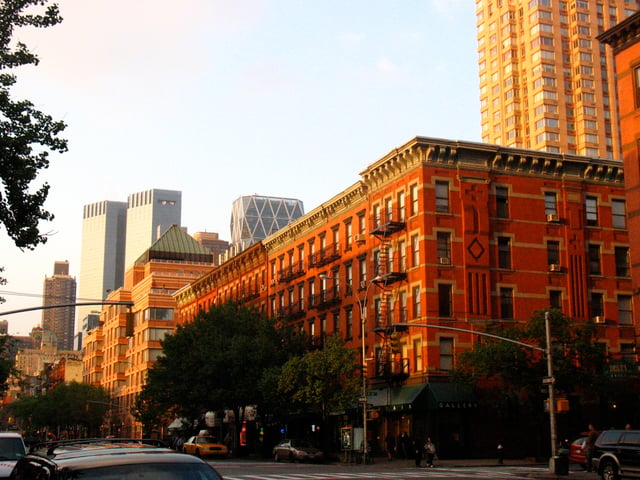
View from between 47th and 48th Streets on Ninth Avenue looking northeast toward Time Warner Center and Hearst Tower
Several explanations exist for the original name. An early use of the phrase appears in a comment Davy Crockett made about another notorious Irish slum in Manhattan, Five Points. According to the Irish Cultural Society of the Garden City Area:
When, in 1835, Davy Crockett said, "In my part of the country, when you meet an Irishman, you find a first-rate gentleman; but these are worse than savages; they are too mean to swab hell's kitchen." He was referring to the Five Points.[8]
According to an article by Kirkley Greenwell, published online by the Hell's Kitchen Neighborhood Association:
No one can pin down the exact origin of the label, but some refer to a tenement on 54th Street as the first "Hell's Kitchen." Another explanation points to an infamous building at 39th as the true original. A gang and a local dive took the name as well.... a similar slum also existed in London and was known as Hell's Kitchen.[9]
Local historian Mary Clark explained the name thus:
...first appeared in print on September 22, 1881 when a New York Times reporter went to the West 30s with a police guide to get details of a multiple murder there. He referred to a particularly infamous tenement at 39th Street and Tenth Avenue as "Hell's Kitchen" and said that the entire section was "probably the lowest and filthiest in the city." According to this version, 39th Street between 9th and 10th Avenues became known as Hell's Kitchen and the name was later expanded to the surrounding streets. Another version ascribes the name's origins to a German restaurant in the area known as Heil's Kitchen, after its proprietors.[10] But the most common version traces it to the story of "Dutch Fred the Cop", a veteran policeman, who with his rookie partner, was watching a small riot on West 39th Street near Tenth Avenue. The rookie is supposed to have said, "This place is hell itself", to which Fred replied, "Hell's a mild climate. This is Hell's Kitchen."[11]
The 1929 book Manna-Hatin: The Story of New York states that the Panic of 1857 led to gangs formed "in the notorious 'Gas House District' at Twenty-First Street and the East River, or in 'Hell's Kitchen', in the West Thirties."[12]
Hell's Kitchen has become the most frequently used name of the neighborhood, even though real estate developers have offered alternatives of "Clinton" and "Midtown West", or even "the Mid-West". The "Clinton" name, used by the municipality of New York City, originated in 1959 in an attempt to link the area to DeWitt Clinton Park at 52nd and Eleventh Avenue, named after the 19th century New York governor.[13]
History
Early history and development
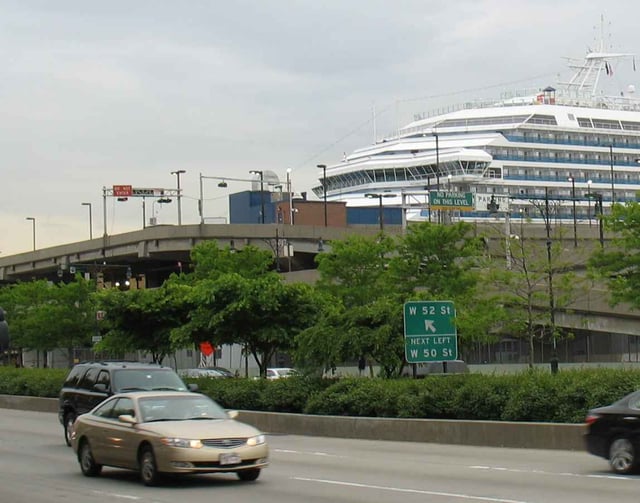
New York Passenger Ship Terminal in Hell's Kitchen at 52nd Street
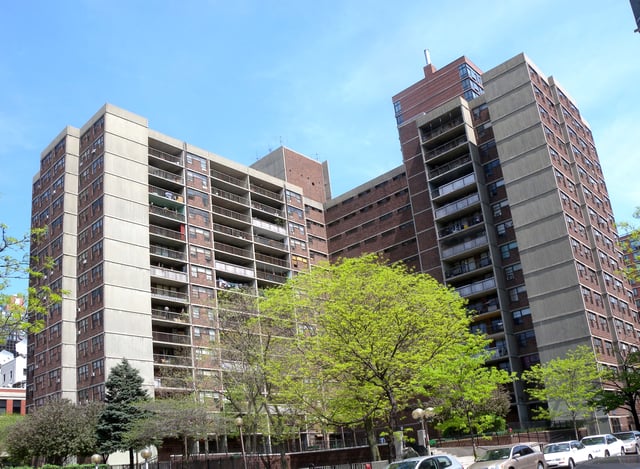
Harborview Terrace public housing buildings between West 54th and West 56th Streets, and Tenth and Eleventh Avenues, part of the New York City Housing Authority[19]
On the island of Manhattan as it was when Europeans first saw it, the Great Kill formed from three small streams that united near present-day Tenth Avenue and 40th Street, and then wound through the low-lying Reed Valley, renowned for fish and waterfowl,[14] to empty into the Hudson River at a deep bay on the river at the present 42nd Street.[15] The name was retained in a tiny hamlet called Great Kill, which became a center for carriage-making, while the upland to the south and east became known as Longacre, the predecessor of Longacre Square (now Times Square).[16]
One of the large farms of the colonial era in this neighborhood was that of Andreas Hopper and his descendants, extending from today's 48th Street nearly to 59th Street and from the river east to what is now Sixth Avenue. One of the Hopper farmhouses, built in 1752 for John Hopper the younger, stood near 53rd Street and Eleventh Avenue; christened "Rosevale" for its extensive gardens, it was the home of the War of 1812 veteran, Gen. Garrit Hopper Striker, and lasted until 1896, when it was demolished. The site was purchased for the city and naturalistically landscaped by Samuel Parsons Jr. as DeWitt Clinton Park. In 1911 New York Hospital bought a full city block largely of the Hopper property, between 54th and 55th Streets, Eleventh and Twelfth Avenues.[17] Beyond the railroad track, projecting into the river at 54th Street, was Mott's Point, with an 18th-century Mott family house surrounded by gardens that was inhabited by members of the family until 1884 and survived until 1895.[18]
A lone surviving structure that dates from the time this area was open farmland and suburban villas is a pre-1800s carriage house that once belonged to a villa owned by former Vice President and New York State governor George Clinton, now in a narrow court behind 422 West 46th Street.[20] From 1811 until it was officially de-mapped in 1857, the diminutive Bloomingdale Square was part of the city's intended future; it extended from 53rd to 57th Streets between Eighth and Ninth Avenues. It was eliminated after the establishment of Central Park,[21] and the name shifted to the junction of Broadway, West End Avenue, and 106th Street, now Straus Park. In 1825, the City purchased for $10 clear title to a right-of-way through John Leake Norton's[1] farm, "The Hermitage", to lay out 42nd Street clear to the river. Before long, cattle ferried from Weehawken were being driven along the unpaved route to slaughterhouses on the East Side.[22] Seventy acres of the Leakes' (later the Nortons') property, extending north from 42nd to 46th Street and from Broadway to the river, had been purchased before 1807 by John Jacob Astor and William Cutting, who held it before dividing it into building lots as the district became more suburban.
Unity with the city and deterioration
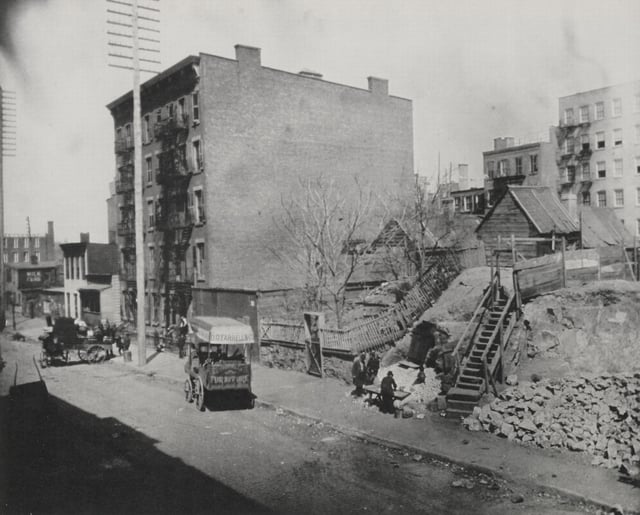
Hell's Kitchen and Sebastopol, c. 1890, photographed by Jacob Riis

Mission House, Hell's Kitchen, c. 1915
There were multiple changes that helped Hell's Kitchen integrate with New York City proper. The first was construction of the Hudson River Railroad, whose initial leg – the 40 miles (64 km) to Peekskill – was completed on September 29, 1849, By the end of 1849, it stretched to Poughkeepsie and in 1851 it extended to Albany. The track ran at a steep grade up Eleventh Avenue, as far as 60th Street. [23]
The formerly rural riverfront was industrialized by businesses, such as tanneries, that used the river for shipping products and dumping waste. The neighborhood that would later be known as Hell's Kitchen started forming in the southern part of the 22nd Ward in the mid-19th century. Irish immigrants – mostly refugees from the Great Famine – found work on the docks and railroad along the Hudson River and established shantytowns there.
After the American Civil War, there was an influx of people who moved to New York City. The tenements that were built became overcrowded quickly. Many who lived in this congested, poverty-stricken area turned to gang life. Following Prohibition, implemented in 1919, the district's many warehouses were ideal locations for bootleg distilleries for the rumrunners who controlled illicit liquor. At the start of the 20th century, the neighborhood was controlled by gangs, including the violent Gopher Gang led by One Lung Curran and later by Owney Madden.[24] Early gangs, like the Hell's Kitchen Gang, transformed into organized crime entities, around the same time that Owney Madden became one of the most powerful mobsters in New York. It became known as the "most dangerous area on the American Continent".
After the repeal of Prohibition, many of the organized crime elements moved into other rackets, such as illegal gambling and union shakedowns. The postwar era was characterized by a flourishing waterfront, and longshoreman work was plentiful. By the end of the 1950s, however, the implementation of containerized shipping led to the decline of the West Side piers and many longshoremen found themselves out of work. In addition, construction of the Lincoln Tunnel, Lincoln Tunnel access roads, and the Port Authority Bus Terminal and ramps destroyed much of Hell's Kitchen south of 41st Street.[25]-
In 1959, an aborted rumble between rival Irish and Puerto Rican gangs led to the notorious "Capeman" murders in which two innocent teenagers were killed. By 1965, Hell's Kitchen was the home base of the Westies, an Irish mob aligned with the Gambino crime family. It was not until the early 1980s that widespread gentrification began to alter the demographics of the longtime working-class Irish American neighborhood. The 1980s also saw an end to the Westies' reign of terror, when the gang lost all of its power after the RICO convictions of most of its principals in 1986.
First wave of gentrification
Special Clinton zoning district
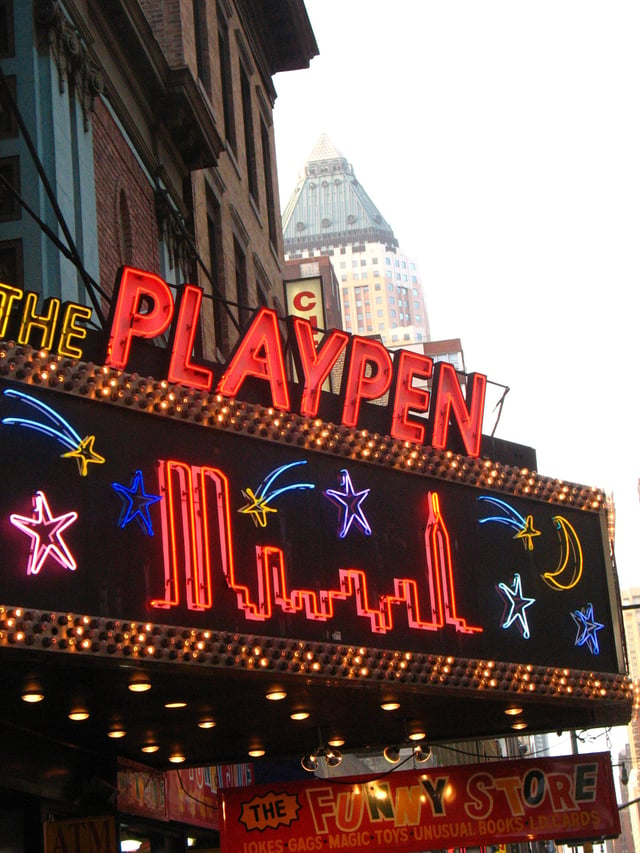
Eighth Avenue was once lined with porn stores and theaters. The stores have been mostly gone since the late 1990s, but this particular store, which was highlighted in the 2003 film Phone Booth, remained until 2007.
Although the neighborhood is immediately west of New York's main business district, large-scale redevelopment has been kept in check for more than 40 years by strict zoning rules in a Special Clinton District[26] designed to protect the neighborhood's residents and its low-rise character.
In part to qualify for federal aid, New York developed a comprehensive Plan for New York City in 1969–70. For Hell's Kitchen, the master plan called for two to three thousand hotel rooms, 25,000 apartments, 25,000,000 square feet (2,300,000 m2) of office space, a new super liner terminal, a subway along 48th Street, and a convention center to replace what the plan described as "blocks of antiquated and deteriorating structures of every sort."[27][28] However, outrage at the massive residential displacement that this development project would have caused,[29] and the failure of the City to complete any replacement housing, led to opposition to the first project – a new convention center to replace the New York Coliseum.[30]
To prevent the convention center from sparking a development boom that would beget the rest of the master plan with its consequent displacement, the Clinton Planning Council and Daniel Gutman, their environmental planner, proposed that the convention center and all major development be located south of 42nd Street where public policy had already left tracts of vacant land.[31]
Nevertheless, in 1973 the Jacob K. Javits Convention Center was approved for a 44th Street site that would replace piers 84 and 86. But in exchange, and after the defeat of a bond issue that would have funded a 48th Street "people mover,"[32] the City first abandoned the rest of the 1969–70 master plan[33] and then gave the neighborhood a special zoning district to restrict further redevelopment.[34] Since then, limited new development has filled in the many empty lots and rejuvenated existing buildings. Later, in 1978, when the city could not afford to construct the 44th Street convention center, the Mayor and Governor chose the rail yard site originally proposed by the local community.[35] Major office and residential development south of 42nd Street indeed followed, albeit much later, after the City initiated the Hudson Yards Redevelopment Project and started construction on the 7 subway extension
The SCD was originally split into four areas:
Preservation Area: 43rd to 56th Streets between Eighth and Tenth Avenues. R-7 density, 6-story height limit on new buildings, suggested average apartment size of two bedrooms (this was a response to the fact that between 1960 and 1970 developers had torn down 2,300 family-sized units and replaced them with 1,500 smaller units).
Perimeter Area: Eighth Avenue, 42nd and 57th Streets. Bulkier development permitted to counterbalance the downzoning in the preservation area.
Mixed Use Area: Tenth and Eleventh Avenues between 43rd and 50th Streets. Mixed residential and manufacturing. New residential development only permitted in conjunction with manufacturing areas. Later combined into "Other Areas".
Other Areas: West of Eleventh Avenue. Industrial and waterfront uses. Later combined with "Mixed Use Area"
Special permits are required for all demolition and construction in the SCD, including demolition of "any sound housing in the District" and any rehabilitation that increases the number of dwellings in a structure. In the original provisions. no building could be demolished unless it was unsound. New developments, conversions, or alterations that create new units or zero bedroom units must contain at least 20% two bedroom apartments with a minimum room size of 168 square feet (16 m2). Alterations that reduce the percentage of two-bedroom units are not permitted unless the resulting building meets the 20% two-bedroom requirement. Finally, building height in the Preservation Area cannot exceed 66 feet (20 m) or seven stories, whichever is less.
Windermere
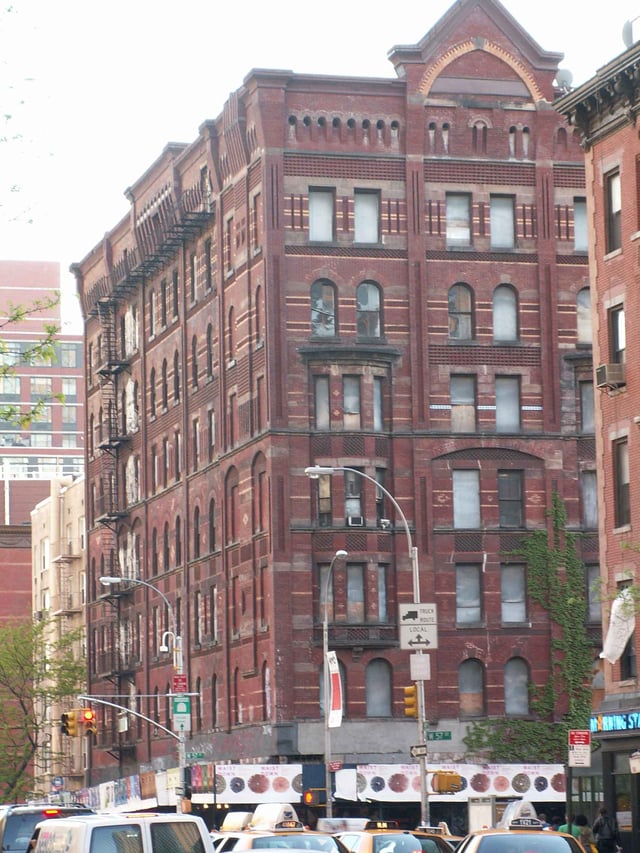
Windermere Apartments at 57th and Ninth
As the gentrification pace increased, there were numerous reports of problems between landlords and tenants. The most extreme example was the eight-story Windermere complex at the southwest corner of Ninth Avenue and 57th Street. Built in 1881, it is the second-oldest large apartment house in Manhattan.[36][37]
In 1980, the owner, Alan B. Weissman, tried to empty the building of its tenants. According to former tenants and court papers, rooms were ransacked, doors were ripped out, prostitutes were moved in, and tenants received death threats in the campaign to empty the building. All the major New York newspapers covered the trials that sent the Windermere's managers to jail. Although Weissman was never linked to the harassment, he and his wife made top billing in the 1985 edition of *The Village Voice'*s annual list, "The Dirty Dozen: New York's Worst Landlords."[38] Most of the tenants eventually settled and moved out of the building. As of May 2006, seven tenants remained[39] and court orders protecting the tenants and the building allowed it to remain in derelict condition even as the surrounding neighborhood was experiencing a dramatic burst of demolition and redevelopment. Finally, in September 2007, the fire department evacuated those remaining seven residents from the building, citing dangerous conditions, and padlocked the front door.[40] In 2008 the New York Supreme Court ruled that the owners of the building, who include the TOA Construction Corporation of Japan, must repair it.[41]
Failed rezoning attempts
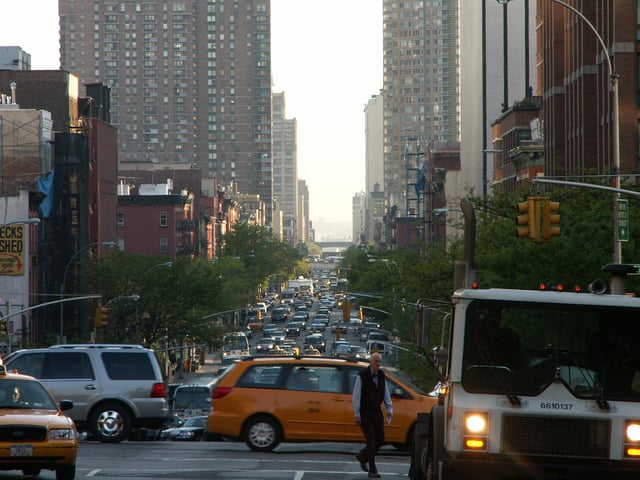
Looking south on Tenth Avenue from 59th Street
By the 1980s the area south of 42nd Street was in decline. Both the state and the city hoped that the Jacob K. Javits Convention Center would renew the area.[42] Hotels, restaurants, apartment buildings, and television studios were proposed.[43] One proposal included apartments and hotels on a 30 acres (12 ha) pier jutting out onto Hudson River, which also included a marina, ferry slip, stores, restaurants, and a performing arts center.[44] At Ninth Avenue and 33rd Street, a 32-story office tower would be built.[45] Hotels, apartment buildings, and a Madison Square Garden would be built over the tracks west of Pennsylvania Station.[46][47] North of the Javits Center, a "Television City" would be developed by Larry Silverstein in conjunction with NBC.[43]
One impediment to development was that there was a lack of mass transit in the area, which is far from Penn Station, and none of the proposals for a link to Penn Station were pursued successfully (for example, the ill-fated West Side Transitway[48]). No changes to the zoning policy happened until 1990, when the city rezoned a small segment of 11th Avenue near the Javits Center.[49][50] In 1993, part of 9th Avenue between 35th and 41st Streets was also rezoned.[51][52] However, neither of these rezonings was particularly significant, as most of the area was still zoned as a manufacturing district with low-rise apartment buildings.[53]
By the early 1990s, there was a recession, which scuttled plans for rezoning and severely reduced the amount of development in the area.[54] After the recession was over, developers invested in areas like Times Square, eastern Hell's Kitchen, and Chelsea, but mostly skipped the Far West Side.[55]
September 11, 2001
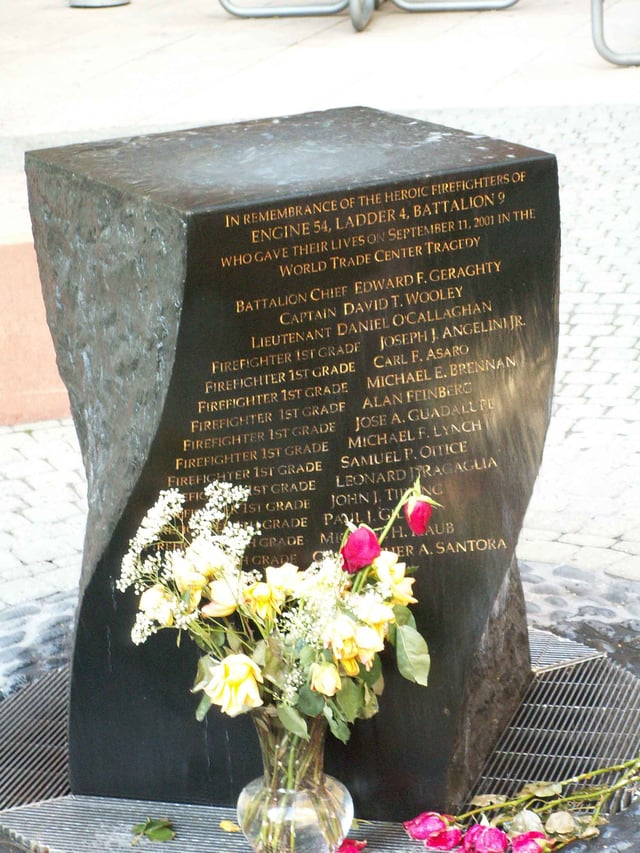
Memorial to 15 firefighters from Engine Co. 54/Ladder Co. 4/Battalion 9 who died on September 11, 2001
While most fire stations in Manhattan lost firefighters in the September 11, 2001, terrorist attacks, the station with the greatest loss of firefighters was Engine Co. 54/Ladder Co. 4/Battalion 9 at 48th Street and Eighth Avenue, which lost 15 firefighters.[56] Given its proximity to Midtown, the station has specialized in skyscraper fires and rescues; in 2007, it was the second-busiest firehouse in New York City, with 9,685 runs between the two companies.[57] Its patch reads "Pride of Midtown" and "Never Missed a Performance". Memorials dot the station's exterior walls and a granite memorial is in a park to its north. Ladder 21, the "Pride of Hell's Kitchen", located on 38th Street between Ninth and Tenth Avenues, and stationed with Engine Co. 34, lost seven firefighters on September 11.[58] In addition, on September 11, Engine Co. 26 was temporarily stationed with Engine Co. 34/Ladder Co. 21 and lost many firefighters themselves.
Redevelopment and second wave of gentrification
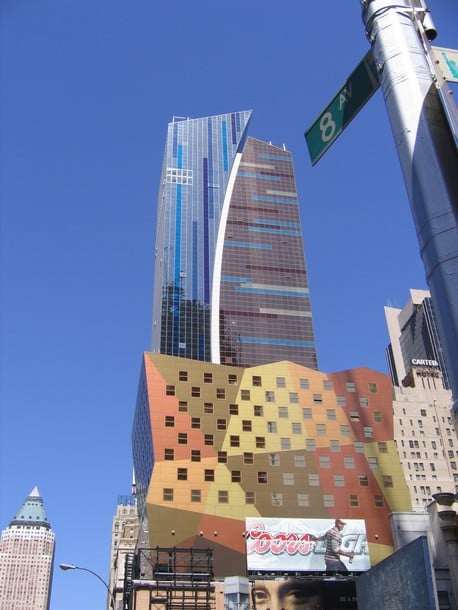
Looking north on 8th Avenue from 42nd Street
Hell's Kitchen has become an increasingly upscale neighborhood of affluent young professionals as well as residents from the "old days",[59][60][61] with rents in the neighborhood having increased dramatically above the average in Manhattan.[62] It has also acquired a large and diverse community as residents have moved north from Chelsea. Zoning has long restricted the extension of Midtown Manhattan's skyscraper development into Hell's Kitchen, at least north of 42nd Street.[63] The David Childs- and Frank Williams-designed Worldwide Plaza established a beachhead when it was built in 1989 at the former Madison Square Garden site, a full city block between 49th and 50th Streets and between Eighth and Ninth Avenues that was exempt from special district zoning rules. This project led a real-estate building boom on Eighth Avenue, including the Hearst Tower at 56th Street and Eighth Avenue. An indication of how fast real estate prices rose in the neighborhood was a 2004 transaction involving the Howard Johnson's Motel at 52nd and Eighth Avenue. In June, Vikram Chatwal's Hampshire Hotel Group bought the motel and adjoining SIR (Studio Instrument Rental) building for $9 million. In August, they sold the property to Elad Properties for about $43 million. Elad, which formerly owned the Plaza Hotel, is in the process of building The Link, a luxury 44-story building.
The most prominent real estate project in the area is the Hudson Yards Redevelopment Project, which will include over 45 million square feet of commercial and residential development, a renovation of the Jacob K. Javits Convention Center, and an extension of the IRT Flushing Line to the 34th Street–Hudson Yards station at 34th Street and 11th Avenue. This new station for 7 and <7> trains opened on September 13, 2015.[64][65] Hudson Yards includes a mixed-use real estate development by Related Companies and Oxford Properties over the MTA's West Side Yard which is expected to consist of 16 skyscrapers containing more than 12,700,000 square feet (1,180,000 m2) of new office, residential, and retail space. six million square feet (560,000 m2) of commercial office space, a 750,000-square-foot (70,000 m2) retail center with two levels of restaurants, cafes, markets and bars, a hotel, a cultural space, about 5,000 residences, a 750-seat school, and 14 acres (5.7 ha) of public open space.[66] Development on the rail yard site officially broke ground on December 4, 2012, and the first phase was completed in March 2019.[67]
Demographics
Based on data from the 2010 United States Census, the population of Hell's Kitchen (Clinton) was 45,884, an increase of 5,289 (13.0%) from the 40,595 counted in 2000. Covering an area of 422.45 acres (170.96 ha), the neighborhood had a population density of 108.6 inhabitants per acre (69,500/sq mi; 26,800/km2).[3] The racial makeup of the neighborhood was 56.4% (25,891) White, 6.3% (2,869) African American, 0.2% (70) Native American, 15.0% (6,886) Asian, 0.1% (31) Pacific Islander, 0.4% (181) from other races, and 2.4% (1,079) from two or more races. Hispanic or Latino of any race were 19.3% (8,877) of the population.[4]
The entirety of Community District 4, which comprises Hell's Kitchen and Chelsea, had 122,119 inhabitants as of NYC Health's 2018 Community Health Profile, with an average life expectancy of 83.1 years.[68] [] This is higher than the median life expectancy of 81.2 for all New York City neighborhoods.[69] [] [70] Most inhabitants are adults: a plurality (45%) are between the ages of 25–44, while 26% are between 45–64, and 13% are 65 or older. The ratio of youth and college-aged residents was lower, at 9% and 8% respectively.[68] []
As of 2017, the median household income in Community Districts 4 and 5 (including Midtown Manhattan) was $101,981,[71] though the median income in Hell's Kitchen individually was $98,727.[5] In 2018, an estimated 11% of Hell's Kitchen and Chelsea residents lived in poverty, compared to 14% in all of Manhattan and 20% in all of New York City. One in twenty residents (5%) were unemployed, compared to 7% in Manhattan and 9% in New York City. Rent burden, or the percentage of residents who have difficulty paying their rent, is 41% in Hell's Kitchen and Chelsea, compared to the boroughwide and citywide rates of 45% and 51% respectively. Based on this calculation, as of 2018, Hell's Kitchen and Chelsea are considered to be high-income relative to the rest of the city and not gentrifying.[68] []
Culture
Entertainment industry
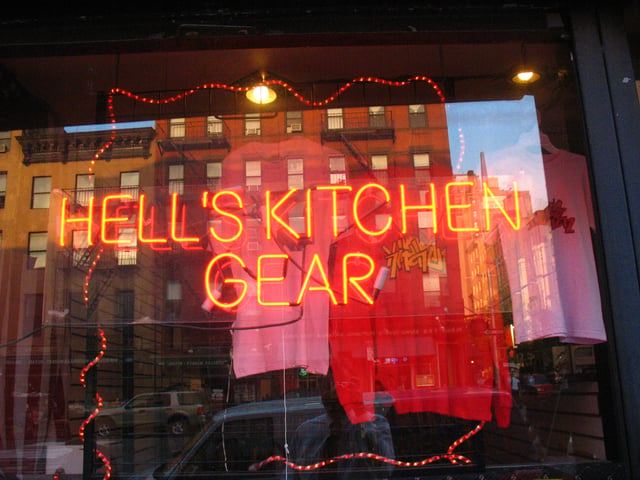
Hell's Kitchen gear for sale in the Video Cafe on Ninth Avenue (shop closed in January 2014)[72]
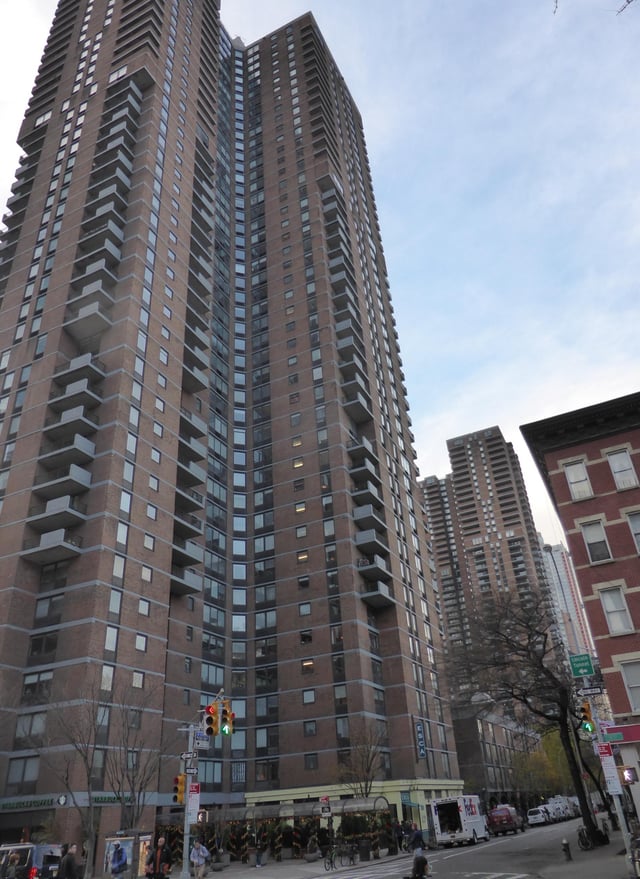
Manhattan Plaza, performing artists' residence, Ninth Avenue/43rd Street
Hell's Kitchen's gritty reputation had made its housing prices lower than elsewhere in Manhattan. Given the lower costs in the past and its proximity to Broadway theatres, the neighborhood is a haven for aspiring actors.[73] Many famous actors and entertainers have resided there, including Burt Reynolds, Rip Torn, Bob Hope, Charlton Heston, James Dean, Madonna, Jerry Seinfeld, Larry David, Alicia Keys, and Sylvester Stallone. This is due in large part to the Actors Studio on West 44th at which Lee Strasberg taught and developed method acting.
With the opening of the original Improv by Budd Friedman in 1963, the club became a hangout for singers to perform but quickly attracted comedians, as well, turning it into the reigning comedy club of its time. Once located near West 44th Street and Ninth Avenue, it has since shuttered, replaced by a restaurant.
Manhattan Plaza at 43rd Street between Ninth and Tenth Avenues was built in the 1970s to house artists. It consists of two 46-story towers with 70% of the apartments set aside for rent discounts for those who work in the arts.[74] The Actors' Temple and St. Malachy Roman Catholic Church with its Actors' Chapel also testify to the long-time presence of show business people.
The neighborhood is also home to a number of broadcast and music-recording studios, including the CBS Broadcast Center at 524 West 57th Street, where the CBS television network records many of its news and sports programs such as 60 Minutes and The NFL Today; the former Sony Music Studios at 460 West 54th Street, which closed in 2007; Manhattan Center Studios at 311 West 34th Street; and Right Track Recording's Studio A509 orchestral recording facility at West 38th Street and Tenth Avenue. The syndicated Montel Williams Show is also taped at the Unitel Studios, 433 West 53rd Street, between Ninth and Tenth Avenues. In 2016, rock music singer and songwriter Sting recorded his album entitled 57th & 9th at Avatar Studios, a music studio located near the intersection of 57th Street and Ninth Avenue in Hell's Kitchen.[75]
The Comedy Central satirical news program The Daily Show has been taped in Hell's Kitchen since its debut. In 2005, it moved from its quarters at 54th Street and Tenth Avenue to a new studio in the neighborhood, at 733 Eleventh Avenue, between 51st and 52nd Streets. The 54th and 10th location was used for The Colbert Report throughout its entire run from 2005 until 2014. Until its cancellation, the studio was used for The Nightly Show with Larry Wilmore, following Stephen Colbert's departure from Comedy Central. Next door at 511 West 54th Street is Ars Nova theater, home to emerging artists Joe Iconis and breakout star Jesse Eisenberg, among others.
The headquarters of Troma studios was located in Hell's Kitchen before their move to Long Island City in Queens. The Baryshnikov Arts Center opened at 37 Arts on 37th Street in 2005, the Orchestra of St. Luke's opened the DiMenna Center for Classical Music in the same building in 2011. The Alvin Ailey American Dance Theater opened at 55th Street and Ninth Avenue in 2006. The Metropolitan Community Church of New York, geared toward an LGBTQ membership, is located in Hell's Kitchen.
Food
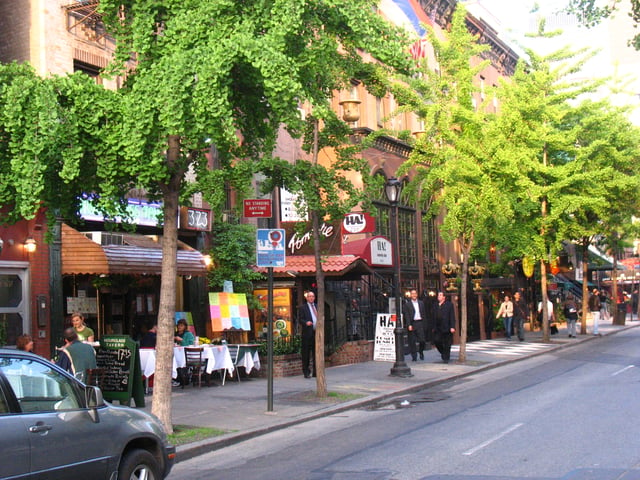
Restaurant Row on West 46th Street
Ninth Avenue is noted for its many ethnic restaurants. The Ninth Avenue Association's International Food Festival stretches through the Kitchen from 42nd to 57th Streets every May, usually on the third weekend of the month.[76] It has been going on since 1974 and is one of the oldest street fairs in the city. There are Caribbean, Chinese, French, German, Greek, Italian, Irish, Mexican, and Thai restaurants as well as multiple Afghan, Argentine, Ethiopian, Peruvian, Turkish, Indian, Pakistani, and Vietnamese restaurants. Restaurant Row, so called because of the abundance of restaurants, is located on West 46th Street between Eighth and Ninth Avenues. Notable establishments on Ninth Avenue include Mickey Spillane's, part-owned by the mobster's son, who also owns Mr Biggs on Tenth Avenue/43rd Street. There are more restaurants and food carts and trucks on Tenth Avenue between 43rd and 47th Streets, including Hallo Berlin.
USS Intrepid Museum
The Intrepid Sea, Air & Space Museum is located at Hudson River Pier 86, 46th Street. Besides the aircraft carrier USS Intrepid, the museum exhibits the cruise missile submarine USS Growler, a Concorde SST, a Lockheed A-12 supersonic reconnaissance plane, and the Space Shuttle Enterprise.
Parks and recreation
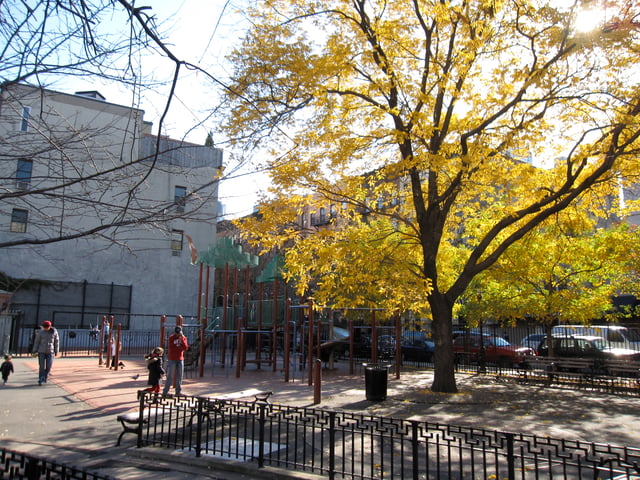
Hell's Kitchen Park
Hell's Kitchen's side streets are mostly lined with trees. The neighborhood does not have many parks or recreational areas, though smaller plots have been converted into green spaces.
A newer park in Hell's Kitchen is the Hudson Park and Boulevard, which is part of the Hudson Yards Redevelopment Project.[78]
The 100 by 150 foot (30 by 46 m) Clinton Community Garden is located on West 48th Street between Ninth and Tenth Avenues, and consists of 108 plots. Previously a haven for illegal activity, in 1978 the West 48th Street Block Association joined with the Green Guerillas to secure a lease for the site to renovate it for community use. When the city put it up for auction in 1981, residents formed the Committee to Save Clinton Community Garden, through both appeals to Mayor Ed Koch and unsuccessful efforts to purchase the site. In 1984, one month before the auction, the garden was transferred to the city's Parks Department, making it the first community garden to become parkland. It is open from dawn to dusk, and over 2,000 residents have keys to the park, which is used by an average of 500–600 people, including over 100 children, during the warm months. Recreational programs provide for events that include an annual Summer Solstice event, art shows, chamber music picnics, gardening seminars, and dance recitals. Residents have also held weddings in the park, and photographers have used it for photo shoots.[79]
Police and crime
Hell's Kitchen is patrolled by two precincts of the NYPD.[80] The area south of 42nd Street is patrolled by the 10th Precinct of the NYPD, located at 230 West 20th Street in Chelsea,[81] while the area north of 42nd Street is patrolled by the 18th (Midtown North) Precinct, located at 306 West 54th Street.[82] The 10th Precinct ranked 61st safest out of 69 patrol areas for per-capita crime in 2010,[83] while the Midtown North and Midtown South precincts ranked 69th safest out of 69 patrol areas for per-capita crime.[84] With a non-fatal assault rate of 34 per 100,000 people, Hell's Kitchen and Chelsea's rate of violent crimes per capita is less than that of the city as a whole. The incarceration rate of 313 per 100,000 people is lower than that of the city as a whole.[68] []
The 10th Precinct has a lower crime rate than in the 1990s, with crimes across all categories having decreased by 74.8% between 1990 and 2018. The precinct saw 1 murder, 19 rapes, 81 robberies, 103 felony assaults, 78 burglaries, 744 grand larcenies, and 26 grand larcenies auto in 2018.[85] The 18th Precinct also has a lower crime rate than in the 1990s, with crimes across all categories having decreased by 84.2% between 1990 and 2018. The precinct saw 3 murders, 21 rapes, 130 robberies, 190 felony assaults, 175 burglaries, 1,875 grand larcenies, and 31 grand larcenies auto in 2018.[86]
Fire safety
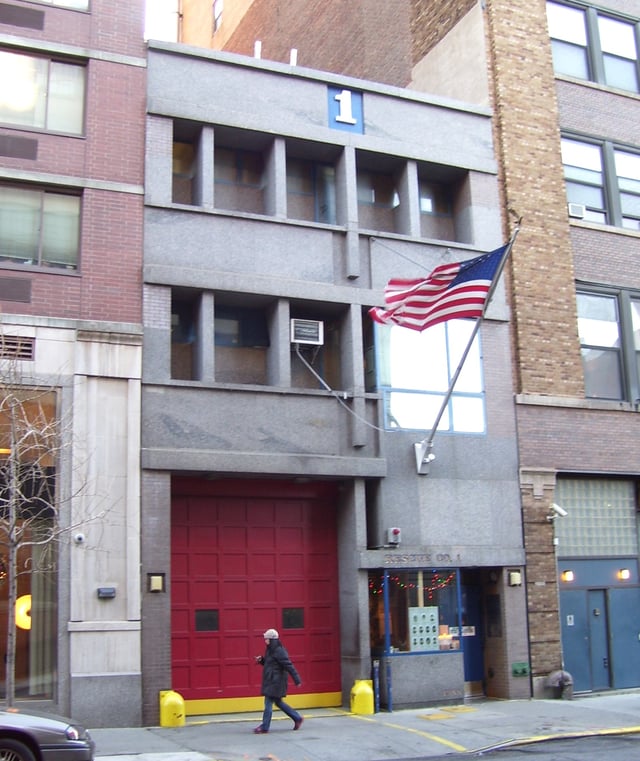
Rescue 1
Hell's Kitchen is served by four New York City Fire Department (FDNY) fire stations:[87]
Health
Preterm births in Hell's Kitchen and Chelsea are the same as the city average, though teenage births are less common. In Hell's Kitchen and Chelsea, there were 87 preterm births per 1,000 live births (compared to 87 per 1,000 citywide), and 9.9 teenage births per 1,000 live births (compared to 19.3 per 1,000 citywide).[68] [] Hell's Kitchen and Chelsea have a low population of residents who are uninsured. In 2018, this population of uninsured residents was estimated to be 11%, slightly less than the citywide rate of 12%.[68] []
The concentration of fine particulate matter, the deadliest type of air pollutant, in Hell's Kitchen and Chelsea is 0.0098 milligrams per cubic metre (9.8×10−9 oz/cu ft), more than the city average.[68] [] Eleven percent of Hell's Kitchen and Chelsea residents are smokers, which is less than the city average of 14% of residents being smokers.[68] [] In Hell's Kitchen and Chelsea, 10% of residents are obese, 5% are diabetic, and 18% have high blood pressure—compared to the citywide averages of 24%, 11%, and 28% respectively.[68] [] In addition, 14% of children are obese, compared to the citywide average of 20%.[68] []
Ninety-one percent of residents eat some fruits and vegetables every day, which is higher than the city's average of 87%. In 2018, 86% of residents described their health as "good," "very good," or "excellent," more than the city's average of 78%.[68] [] For every supermarket in Hell's Kitchen and Chelsea, there are 7 bodegas.[68] []
The nearest major hospitals are the Bellevue Hospital Center and NYU Langone Medical Center in Kips Bay, and NewYork–Presbyterian Hospital in Upper East Side.[92][93]
Post offices and ZIP codes
Hell's Kitchen is located within three primary ZIP Codes. From north to south they are 10018 between 34th and 41st Streets, 10036 between 41st and 48th Streets, and 10019 between 48th and 59th Streets.[94] The United States Postal Service operates three post offices in Hell's Kitchen:
In addition, the James A. Farley Station, the main post office for New York City, is located at 421 8th Avenue.[98]
Education
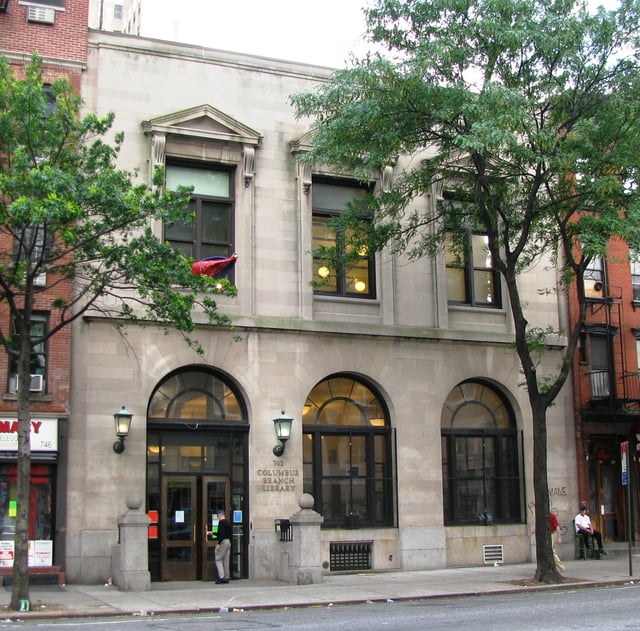
New York Public Library, Columbus branch
Hell's Kitchen and Chelsea generally have a higher rate of college-educated residents than the rest of the city. A majority of residents age 25 and older (78%) have a college education or higher, while 6% have less than a high school education and 17% are high school graduates or have some college education. By contrast, 64% of Manhattan residents and 43% of city residents have a college education or higher.[68] [] The percentage of Hell's Kitchen and Chelsea students excelling in math rose from 61% in 2000 to 80% in 2011, and reading achievement increased from 66% to 68% during the same time period.[99]
Hell's Kitchen and Chelsea's rate of elementary school student absenteeism is lower than the rest of New York City. In Hell's Kitchen and Chelsea, 16% of elementary school students missed twenty or more days per school year, less than the citywide average of 20%.[69] [] [68] [] Additionally, 81% of high school students in Hell's Kitchen and Chelsea graduate on time, more than the citywide average of 75%.[68] []
Schools
The New York City Department of Education operates the following public elementary schools in Hell's Kitchen as part of Community School District 2:[100]
The following high schools are located in Hell's Kitchen, serving grades 9-12 unless otherwise indicated:[100]
Business of Sports School[104]
Facing History School[105]
Food and Finance High School[106]
High School for Environmental Studies[107]
High School of Hospitality Management[108]
Independence High School[109]
Manhattan Bridges High School[110]
Professional Performing Arts School (grades 6-12)[111]
Urban Assembly Gateway School For Technology[112]
Urban Assembly School of Design and Construction[113]
Library
The New York Public Library (NYPL) operates the Columbus branch at 742 10th Avenue. The Columbus branch was founded in 1901 as the Columbus Catholic Club's collection, and it became an NYPL branch four years later. The current Carnegie library building opened in 1909 and was renovated in 2004–2005.[116]
Transportation
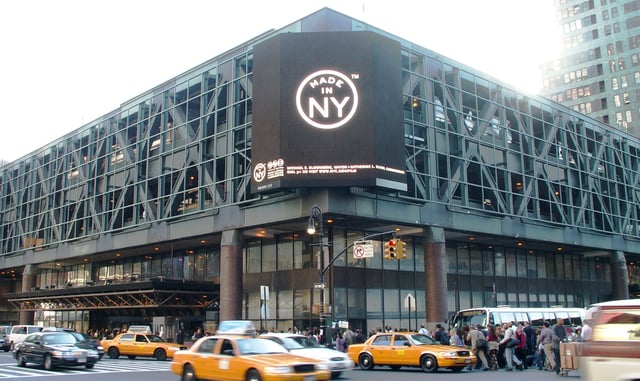
Port Authority Bus Terminal at 42nd and Eighth Avenue
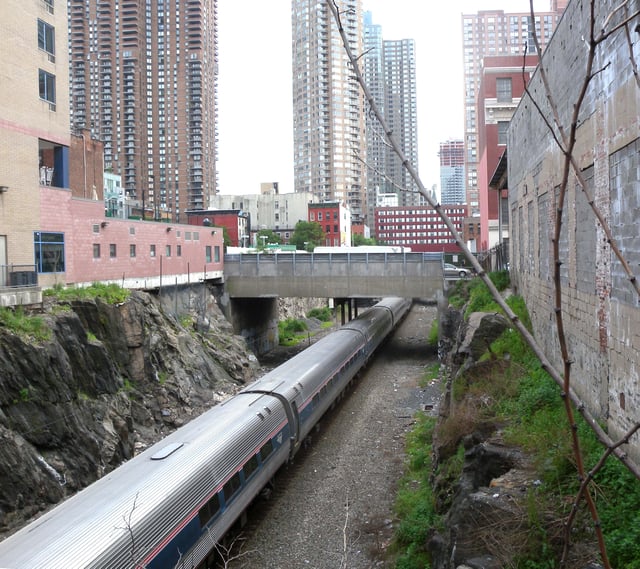
Amtrak train in Empire Connection trench
The Lincoln Tunnel connects New York City to New Jersey. Parking lots dot the neighborhood but are dwindling in quantity as developments are being built. Eleventh Avenue is lined with car dealerships, many of which claim to have the highest volume among all dealerships for their brands in the country.
The massive Port Authority Bus Terminal is between 40th and 42nd Streets and Eighth and Ninth Avenues. Several New York City Bus routes (namely the M11, M12, M31, M34 SBS, M42 and M50, as well as express bus routes) also service the area.
Many of the horse-drawn carriages from Central Park stay in stables just off the West Side Highway. It is not uncommon to hear the sound of horses in the neighborhood. There have been calls for banning horse-drawn carriages, especially from Mayor of New York City Bill de Blasio following a handful of collisions between cars and carriages.[117][118][119] The carriage horses live in historic stables originally built in the 19th century, but today boast the latest in barn design, such as fans, misting systems, box stalls, and state-of-the-art sprinkler systems. As horses always have in densely populated urban areas, the carriage horses live upstairs in their stables while the carriages are parked below on the ground floor.[120][121]
Cruise ships frequently dock at the New York Passenger Ship Terminal in the 48th to 52nd piers called Piers 88, 90, 92. Cruise ship horns are a common sound in the neighborhood. Several French restaurants opened on West 51st Street to accommodate traffic from the French Line. The piers originally built in 1930 are now considered small, and some cruise traffic uses other locations. Other ship operations in the neighborhood include Circle Line Sightseeing Cruises at West 42nd and the NY Waterway ferry service.
Hell's Kitchen begins northwest of Penn Station. Amtrak trains going into the station run along a sunken corridor west of Tenth Avenue, which feeds into the Freedom Tunnel; it is used by approximately thirty trains daily. During the post-9/11 building boom, apartment houses have been built over sections of the train tracks.
Hell's Kitchen is bounded on the east by the New York City Subway's IND Eighth Avenue Line (A, C, and E trains). The MTA built the 7 Subway Extension (7 and <7> trains) for the aforementioned Hudson Yards development. The extension to 34th Street–Hudson Yards opened on September 13, 2015,[64][65] making the IRT Flushing Line the westernmost New York City Subway line within Midtown.[122]
In popular culture
Comics
The Marvel Comics superhero Daredevil (Matt Murdock), born and raised in Hell's Kitchen, resides in, and intermittently operates his law office out of the neighborhood.
Jessica Jones, another Marvel superhero, also hails from Hell's Kitchen.
The Kitchen, an eight-issue Vertigo Comics miniseries, is a female-driven crime drama set in Hell's Kitchen.[123]
New recruit Nick Fury remembers the tough neighborhood where he's originally from in Sgt. Fury and his Howling Commandos, No. 62, January 1969 issue.
Literature
Within the southern opening of the Freedom Tunnel, the former "shantytowns" constructed by homeless people, now cleared, gave rise to the urban legend of "mole people", as seen in the documentary Dark Days and in Jennifer Toth's book The Mole People: Life in the Tunnels Beneath New York.
The Definite Object – A Romance of New York, a novel (1917) by Jeffery Farnol, features Hell's Kitchen as a key venue
Nero Wolfe (1934), series of novels and short stories
The Fountainhead (1943), novel by Ayn Rand – the character Gail Wynand grows up in Hell's Kitchen, which features as the symbolic site of a building he orders to be made.
The Fortunate Pilgrim (1964), novel by Mario Puzo
American Psycho (1991), novel by Bret Easton Ellis
Devil's Heaven (1995), novel by Thomas Adcock
Sleepers (1995), novel by Lorenzo Carcaterra, and Sleepers, 1996 film
Boxman Jake (1996), story by Daniel Martin Eckhart about an Jewish/Irish family in 1958 Hell's Kitchen
Everybody Dies (1998), novel by Lawrence Block
Hell's Kitchen (2001), novel by Jeffery Deaver
Cosmopolis (2003), novel by Don DeLillo
Mafia Summer (2005), novel by E. Duke Vincent
The Power of the Dog (2005), crime/thriller novel by Don Winslow
Jackson Steeg series novels (2006–09) by Ira Berkowitz
Shamrock Alley (2009), novel by Ronald Malfi
Run for Your Life (2009), novel by James Patterson and Michael Ledwidge
The Spy (2010), novel by Clive Cussler
Television
Route 66 (1960–63), TV show – Buz Murdock, one of the lead characters, grew up in Hell's Kitchen.[124]
Hell On Wheels (2011–16), the character of Thomas C. Durant claims to have grown up in Hell's Kitchen as a boy, which led to his ferocious need for power.
Public Morals (2015), TV show
Several Netflix series set within the Marvel Cinematic Universe such as Daredevil, Jessica Jones, and The Defenders were based and filmed within the neighborhood.
Film
Fail Safe (1964), film by Sidney Lumet.[125]
Taxi Driver (1976), film by Martin Scorsese, filmed and set largely in Hell's Kitchen.[126]
Paradise Alley (1978) film by Sylvester Stallone
State of Grace (1990), film by Phil Joanou
Sleepers (1996), film by Barry Levinson
Bringing Out the Dead (1999), film by Martin Scorsese
In America (2002), by Jim Sheridan
Ash Wednesday (2002), by Edward Burns, set in the Hell's Kitchen of the early 1980s[127]
The Kitchen (2019), based on the Vertigo Comics series
Music
"New York City" (1989), song by The Cult
"Hell's Kitchen" (1997), instrumental song from Dream Theater's 1997 album Falling into Infinity which was recorded at the Power Station recording studio, West 53rd Street
Notable residents
Notable current and former residents of Hell's Kitchen include:
Michael Alig, founder of the Club Kids, lived at Riverbank West (560 West 43rd Street), Apartment 3K,[128] at 11th Avenue, which he described as "the place where I lived as part of my salary at Limelight"; it was the address where he and his roommate, Robert "Freeze" Riggs, killed Andre "Angel" Melendez[129]
Carmelo Anthony (born 1984), basketball player[130]
Benjamin Appel (1907–1977), crime novelist[131]
Reinaldo Arenas (July 16, 1943 – December 7, 1990) Cuban poet
Lewis Black, comic[132]
William H. Bonney ("Billy the Kid"); born Henry McCarty (1859–1881), Wild West outlaw. Grew up in Hell's Kitchen, before moving to the West with his widow mother, according to TV docu-series The American West.
Anthony Bourdain, chef and author[133]
James J. Braddock ("Cinderella Man"), boxer, lived on West 48th Street[134]
James Cagney, actor[135]
George Cain (1943–2010), author of Blueschild Baby.[136]
Lorenzo Carcaterra, author, was born and raised in Hell's Kitchen, which is featured in his autobiographical story "A Safe Place" as well as the novel and later film Sleepers.[137]
Vanessa Carlton (born 1980), singer-songwriter[138]
Paul Cavonis (born 1937), actor[139]
Timothée Chalamet (born 1995), actor, born and raised in Hell's Kitchen[140]
Richard Christy (born 1974), comedian, radio personality, and musician[141]
James Coonan (born 1946), mobster[142]
Larry David (born 1947), actor, producer of Seinfeld and Curb Your Enthusiasm.[143]
Robert De Niro, actor
Tom Devaney, mobster
Bill Dwyer, mobster
Donald Faison, actor
Alice Faye, actress
Mickey Featherstone, mobster
Sutton Foster, stage actor
Robert Fripp, musician
Zach Galligan, actor
Peter H. Gilmore (born 1958), High Priest of the Church of Satan
Marcelo Gomes (born 1979), Brazilian ballet dancer[144]
John Goodman, actor, lived on Ninth Avenue
Tom Gorman (1919–1986), Major League Baseball umpire.[145]
James Gunn, author and filmmaker
Tom Hanks, actor, had an apartment in Hell's Kitchen in the late 1970s/early 1980s.
Charlton Heston, actor, worked as a model in Hell's Kitchen from 1944 to 1947.
Stephan Jenkins of Third Eye Blind, musician
Alicia Keys (born 1981), singer and pianist[146]
Kenny Kramer (born 1943), comedian, lived in a Hell's Kitchen apartment across the hall from Larry David and became the inspiration for the Cosmo Kramer character on Seinfeld.[143]
Stanley Kramer (1913–2001), film director and producer[147]
Reichen Lehmkuhl (born 1973), winner of The Amazing Race and star of The A-List: New York
Mark LoMonaco, professional wrestler, known as Bubba Ray Dudley
Henrik Lundqvist, hockey player and New York Rangers goaltender
Owney Madden, mobster
George Maharis, actor, lived on West 49th
Mary "Typhoid Mary" Mallon shared an apartment in Hell's Kitchen with her boyfriend between jobs as a cook during the 1900s
Eddie McGrath, mobster
Frank Miller (born 1957), writer and comic book artist
Daniel Patrick Moynihan (1927–2003), politician, sociologist, and diplomat.[148]
Hasan Minhaj (born 1985) comedian, writer, and political commentator[149]
Brian Mullen (born 1962), NHL hockey player[150]
Joe Mullen (born 1957), NHL hockey player[150]
Joakim Noah (born 1985), NBA basketball player[151]
Trevor Noah (born 1984), actor[152]
Paul O'Neill (born 1956), producer and founder of Trans-Siberian Orchestra[153]
Jerry Orbach (1935–2004), actor. Kept an apartment on Eighth Avenue between 53rd and 54th Streets.[154]
Tony Orlando (born 1944), singer[155]
Ilka Tanya Payán (1943–1996), actress and AIDS activist[156]
Josh Peck (born 1986), actor, was born and raised in Hell's Kitchen.[157]
George Raft (1901–1980), actor[160]
John Reed (born 1969), author[161]
Mickey Rourke (born 1953), actor[162]
Richie Scheinblum (born 1942), American Major League Baseball All Star outfielder
Max Schneider (born 1992), American singer-songwriter and actor[163]
Stephen Schwartz (born 1948), composer
Kevin Spacey (born 1959), actor[164]
Mickey Spillane (1933–1977), mobster[165]
Sylvester Stallone (born 1946), actor who was born and raised in the area.[166]
Linards Tauns, Latvian modernist poet and spiritual leader of Hell's Kitchen group of immigrant Latvian poets
William M. "Boss" Tweed, political figure, lived at West 51st Street
Lisa Velez (born 1966), singer of Lisa Lisa and Cult Jam[167]
Thomas Wagner a.k.a. "The Cadillac Man" (born 1949), author
Matt Wiese (born 1971), professional wrestler, known as Horshu or Luther Reigns
Bruce Willis (born 1955), actor, lived at West 49th Street and Tenth Avenue as a struggling actor.[168]
